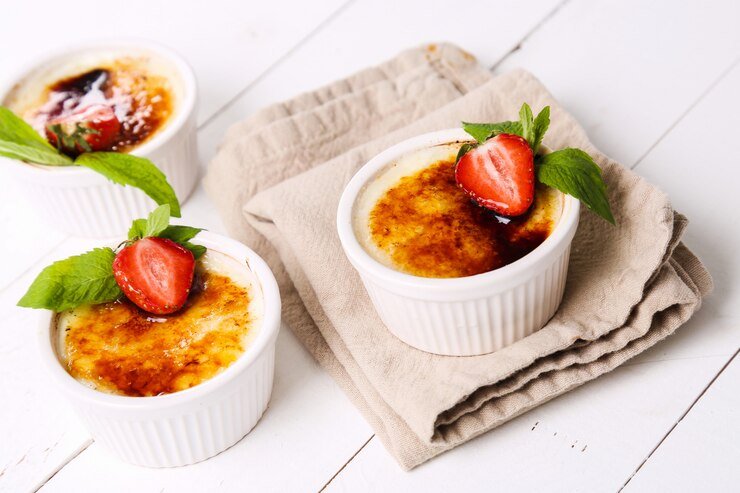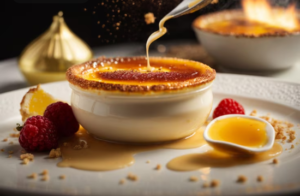Introduction to Burnt Cream
Where did burnt cream come from?Burnt cream, also known as « crème brûlée, » is a dessert known for its creamy custard base and hard caramel top. It gets its name from the French method of caramelizing the sugar topping. Essential ingredients are cream, sugar, vanilla, and egg yolks.
Brief Overview of Its Cultural Significance
Burnt cream has a storied history in European cuisine. Although most often associated with France, its origins are disputed, with claims from Spain and England as well. The dessert became especially popular in the 1980s, symbolizing culinary luxury. In England, it became a signature dish at Cambridge University, where it was served with the university’s coat of arms seared into the caramel top. This evolution reflects its significance in culinary tradition and its lasting appeal.
Historical Origins
Earliest Known Recipes
The first known recipe for burnt cream appeared in François Massialot’s 1691 cookbook « Cuisinier royal et bourgeois. » It described a custard sweetened and topped with caramelized sugar using a hot iron. This early version laid the foundation for the dessert’s refined preparation in French royal kitchens.
Geographic Origins: France and Beyond
Burnt cream’s origins are debated but often linked to France. However, similarities with Spain’s « crema catalana » suggest a broader European heritage. In England, the dessert evolved into « Trinity cream, » showing how it adapted across cultures.
The Role of François Massialot’s Cookbook
Massialot’s cookbook was pivotal in popularizing burnt cream among European aristocracy and standardizing its recipe. His influence extended to England, where the dessert was embraced at Trinity College, Cambridge, and became part of British culinary tradition. This section highlights how burnt cream became a symbol of culinary elegance across Europe.
Evolution Through the Centuries
Variations Across Europe
Burnt cream spread across Europe, adapting to local tastes. In France, it became « crème brûlée, » known for its vanilla richness. Spain developed « crema catalana, » flavored with citrus and cinnamon. Each version reflects regional ingredients and preferences, showing burnt cream’s versatility and popularity.
Introduction to England and Cambridge Burnt Cream
In England, Cambridge University embraced burnt cream, naming it « Cambridge burnt cream » or « Trinity cream. » It features a rich custard with a caramelized top, often branded with the university’s coat of arms. This tradition highlights the dessert’s integration into local culture.
Crème Brûlée vs. Crema Catalana
The crème brûlée and crema catalana debate centers on their differences. Both have a custard base and caramelized top. However, crema catalana uses more cinnamon and citrus, and is caramelized under a broiler, not a torch. This shows the distinct culinary traditions of France and Spain.
This section explores how burnt cream has evolved across Europe, leading to beloved regional desserts that showcase each area’s culinary heritage.
Modern Popularity and Variations
Renaissance in the 1980s
The 1980s marked a significant resurgence in the popularity of burnt cream, particularly in its French form, crème brûlée. This revival can be attributed to the global expansion of French cuisine and its adoption in high-end restaurants worldwide. Chefs began to experiment with the classic recipe, elevating it with premium ingredients like Madagascar vanilla and incorporating techniques that enhanced its texture and flavor. The dessert became a symbol of culinary sophistication and a staple on dessert menus, reflecting a broader trend of rediscovering and glamorizing traditional dishes.
Notable Variations and Contemporary Takes
As burnt cream gained popularity, chefs and home cooks alike began creating innovative variations of the dessert. Notable contemporary takes include the addition of liqueurs, the infusion of exotic spices like cardamom and saffron, and even savory versions incorporating herbs or cheese. Some chefs have experimented with replacing the traditional sugar topping with alternatives like honeycomb or maple syrup, each adding a unique twist to the classic flavor profile.
Burnt Cream in Modern Cuisine
In modern cuisine, burnt cream continues to evolve, adapting to current culinary trends and dietary preferences. Variations now include vegan and lactose-free versions, utilizing coconut milk or almond cream as substitutes. The dessert’s adaptability has also led to its inclusion in fusion dishes, combining elements from different culinary traditions to create new, exciting tastes. This ongoing innovation ensures that burnt cream remains relevant and beloved in contemporary dining experiences.
This section of the article would explore the transformation of burnt cream from a classic dessert to a modern culinary phenomenon, showcasing its versatility and enduring appeal in the food industry.
Making Burnt Cream
Traditional Ingredients and Preparation
The classic burnt cream consists of a few key ingredients: heavy cream, egg yolks, sugar, and vanilla. The traditional method involves gently heating the cream and vanilla until just simmering. Meanwhile, egg yolks and sugar are whisked until pale and fluffy. The hot cream is then gradually added to the egg mixture to temper it, preventing the eggs from curdling. This mixture is poured into ramekins and baked in a water bath at a low temperature until set but still trembling in the center. Once cooled, sugar is sprinkled on top and caramelized using a broiler or torch to create the signature crisp top.
Modern Techniques and Tools
With advancements in culinary technology, chefs and home cooks have refined the making of burnt cream. The use of kitchen torches has become popular for achieving the perfect caramelized top, providing more control and uniformity than a traditional broiler. Some modern recipes also involve using sous-vide techniques to cook the custard at a precise temperature, resulting in an even more silky texture. Innovations like flavor-infused sugars or layering different types of sugars have enhanced the complexity and depth of the caramelized crust.
This section of the article would detail both the classic and contemporary approaches to making burnt cream, highlighting how traditional techniques have melded with modern innovations to keep this beloved dessert both timeless and timely.
The Art of Caramelizing Sugar
Techniques for Perfect Caramelization
Explore the essential temperature control and timing needed for a flawless caramelized top, a hallmark of burnt cream. This section will delve into the precision required in the caramelization process to ensure a crisp, golden layer that contrasts beautifully with the creamy custard beneath.
Tools of the Trade: Torches vs. Broilers
Analyze the use of kitchen torches versus broilers, detailing the benefits and limitations of each. This comparison will help readers understand which tool might best suit their culinary setup and style, facilitating the perfect caramelized sugar crust every time.
Safety Tips for Handling Hot Sugar
Offer practical advice for safely managing hot sugar. This guide will emphasize the dangers of working with caramelized sugar and provide best practices to prevent burns, ensuring a safe cooking environment for all dessert enthusiasts.
This section of the article will enhance understanding of the technical skills involved in perfecting burnt cream, particularly focusing on the caramelization that defines this beloved dessert. It caters to readers interested in the finer details of culinary techniques.
Cultural Impact of Burnt Cream
Burnt Cream in Art and Literature
Burnt cream, with its rich history and iconic status, has found its way into various forms of art and literature, symbolizing luxury and refinement. In literature, authors have used it as a metaphor for indulgence and sensuality, often featured in lavish dining scenes or as a favorite dessert of complex characters. In art, especially in still life paintings, burnt cream is depicted as part of opulent feasts, highlighting its status in high society and its role in social gatherings.
Celebrations and Festivities Featuring Burnt Cream
Burnt cream often graces the table during special occasions and celebrations, owing to its decadent and festive nature. It is a popular choice for anniversaries, weddings, and holiday feasts, especially in regions where it is a traditional dessert. In some cultures, it is prepared with specific variations to mark these events, like adding spices during Christmas or using local fruits during harvest festivals. Its preparation and presentation can become a ceremonial act, showcasing culinary skill and creativity.
This section of the article would explore how burnt cream not only delights the palate but also enriches cultural traditions and artistic expressions, demonstrating its influence beyond the kitchen.
Future Trends in Burnt Cream
Innovations in Burnt Cream Recipes
Culinary trends evolve, and so does burnt cream. Chefs and food enthusiasts use non-traditional ingredients like almond or oat milk for vegan and lactose-intolerant consumers. Global flavors like matcha, turmeric, and chai are also being added. These ingredients reflect today’s diverse culinary scene. Techniques like smoking the custard or adding molecular gastronomy elements, such as foams or gels, are redefining traditional desserts.
Sustainability and Ethical Considerations
The future of burnt cream includes sustainability and ethical practices. Ingredients are sourced locally and seasonally to reduce environmental impact. There’s support for fair-trade practices for exotic items like vanilla and chocolate. The trend towards organic products supports healthier eating and animal welfare. As consumer awareness grows, these factors increasingly shape how desserts like burnt cream are made and viewed.
This section of the article would discuss how innovation and sustainability are likely to shape the future of burnt cream, aligning it with modern culinary trends and environmental consciousness.
FAQs
What is the difference between burnt cream and crème brûlée?
Burnt cream and crème brûlée refer essentially to the same dessert, featuring a custard base topped with a caramelized sugar layer. The term « burnt cream » is more commonly used in the UK, while « crème brûlée » is the French term that has become internationally recognized. The main variations arise in regional recipes and naming conventions, but the basic preparation and ingredients remain consistent between the two.
Can burnt cream be made at home easily?
Yes, burnt cream can be made at home with relative ease. The process requires basic cooking equipment and a few key ingredients: cream, sugar, vanilla, and egg yolks. The main steps involve mixing the custard, baking it in a water bath, and caramelizing the sugar on top. A kitchen torch or a broiler can be used for caramelization. With careful attention to a few critical steps, even novice cooks can achieve a restaurant-quality dessert at home.
What are the best flavors for burnt cream?
While the classic burnt cream features vanilla as the primary flavor, there are numerous variations that can cater to different tastes. Popular flavors include chocolate, coffee, and citrus, which add a unique twist to the traditional recipe. Seasonal spices such as cinnamon, nutmeg, or pumpkin spice are excellent in autumn, while fruit-infused versions using raspberry, lemon, or mango provide a refreshing twist during the warmer months.
This section answers common questions about burnt cream, providing essential insights into its preparation and variations, and making it accessible for both novice and experienced cooks.
Recommended Internal Links
- Quick and Easy Brownies: If your article mentions dessert pairings or simple homemade treats, you can embed a link at the mention of « dessert pairings » to Quick and Easy Brownies.
- Chocolate Fondue: For sections discussing variations of creamy desserts or gourmet dessert options, link « gourmet dessert options » to Chocolate Fondue.
- Strawberry Rhubarb Pie: If there’s a reference to classic or traditional desserts in your article, you can insert a link at « classic desserts » pointing to Strawberry Rhubarb Pie.
- French Crepes: In discussions about European influences on dessert culture, link « European dessert influences » to French Crepes.
Additional Resources and Readings
- History Dish: Burnt Cream, Grandaddy of Creme Brulee
- Link: History Dish Article
- Embed at phrase: « historical records suggest » in the section discussing the origins and early mentions of burnt cream.
- Context: This article provides a historical perspective on burnt cream, discussing its early versions and the cooking techniques used in the past.
- Cake History Notes – The Food Timeline
- Link: Cake History Notes
- Embed at phrase: « symbolizing luxury and refinement » in the section about burnt cream in art and literature.
- Context: This page offers a deep dive into the history of desserts including cakes, which can provide a broader context to the evolution of burnt cream.
- My Restaurant Was My Life for 20 Years. Does the World Need It …
- Link: New York Times Article
- Embed at phrase: « modern culinary trends » in the section discussing future trends and modern adaptations of burnt cream.
- Context: This article reflects on the changing landscape of the restaurant industry and can provide a contemporary look at how traditional dishes like burnt cream fit into today’s culinary world.
Conclusion
Where did burnt cream come from?Burnt cream, or crème brûlée, is more than just a dessert. It’s a global favorite, celebrated for its rich flavor and satisfying texture. Originating in Europe, it has become a staple in fine dining and is often featured in art and literature. This exploration into its history, variations, and future trends shows its adaptability and enduring appeal. As culinary techniques evolve and global flavors influence its preparation, burnt cream continues to delight both traditionalists and culinary adventurers. Whether in its classic form or through innovative variations, burnt cream demonstrates the creativity and popularity of gastronomy. This article not only offers insights into burnt cream but also inspires culinary enthusiasts to explore and innovate.



